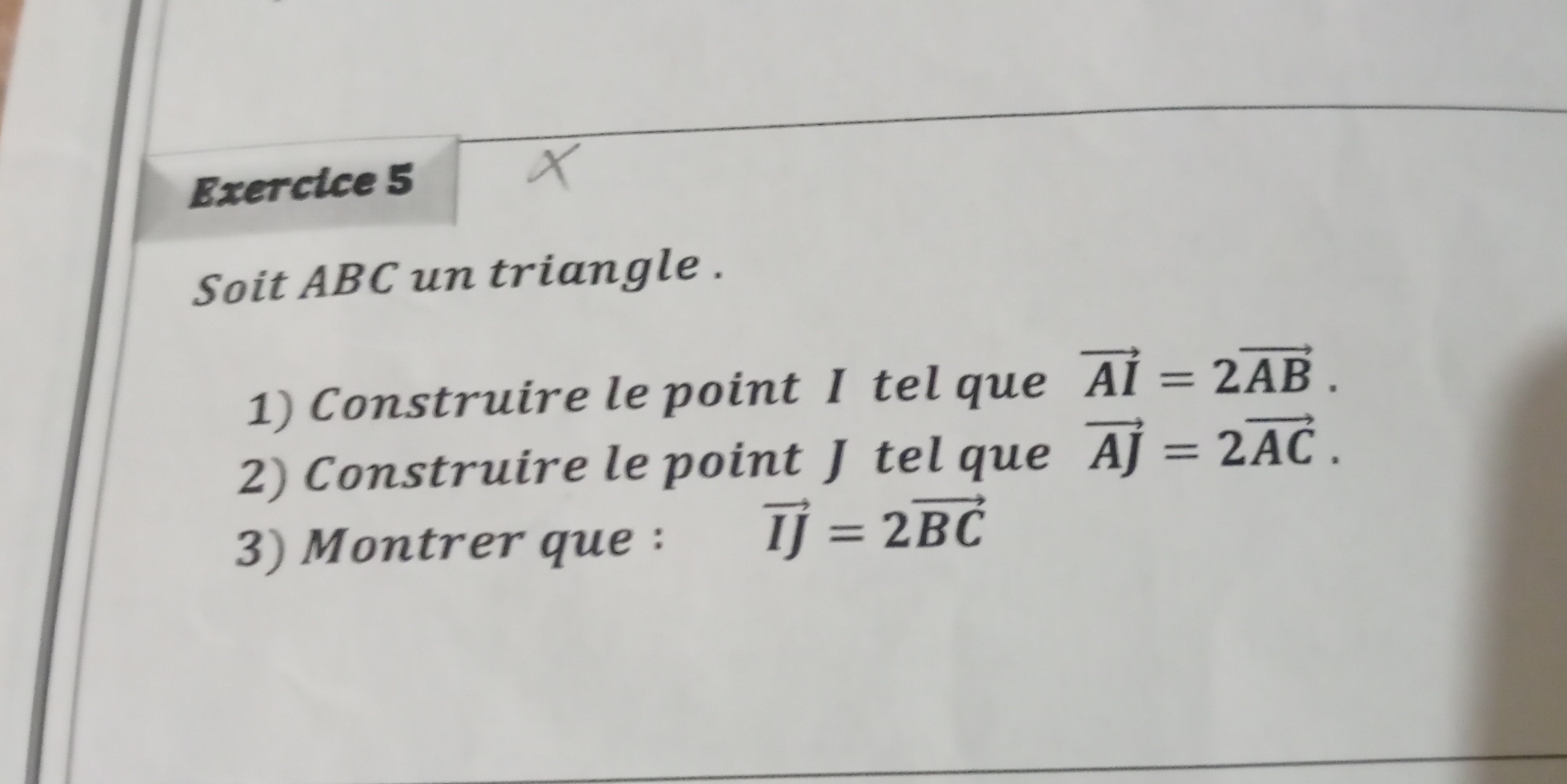Soit ABC un triangle. 1) Construire le point I tel que $\vec{AI} = 2\vec{AB}$. 2) Construire le point J tel que $\vec{AJ} = 2\vec{AC}$. 3) Montrer que : $\vec{IJ} = 2\vec{BC}$

Understand the Problem
La question porte sur la géométrie vectorielle dans un triangle. Elle demande de construire des points I et J en fonction des vecteurs donnés, puis de prouver une relation vectorielle entre les points I, J, B et C. Il s'agit d'un problème typique de mathématiques de niveau lycée.
Answer
$\vec{IJ} = 2\vec{BC}$
Answer for screen readers
$\vec{IJ} = 2\vec{BC}$
Steps to Solve
- Understanding the Construction of point I
The problem states that $\vec{AI} = 2\vec{AB}$. This means the vector $\vec{AI}$ is twice the vector $\vec{AB}$ in the same direction. To construct point I, extend the line segment AB past B to a point I such that the length AI is twice the length of AB.
- Understanding the Construction of point J
Similarly, $\vec{AJ} = 2\vec{AC}$. This means the vector $\vec{AJ}$ is twice the vector $\vec{AC}$ in the same direction. Extend the line segment AC past C to a point J such that the length AJ is twice the length of AC.
- Express $\vec{IJ}$ in terms of $\vec{AJ}$ and $\vec{AI}$
We can write $\vec{IJ}$ as $\vec{AJ} - \vec{AI}$ using the Chasles' relation.
- Substitute the given relations
We know that $\vec{AI} = 2\vec{AB}$ and $\vec{AJ} = 2\vec{AC}$. So, we substitute these into the expression for $\vec{IJ}$:
$$ \vec{IJ} = 2\vec{AC} - 2\vec{AB} $$
- Factor out the constant
Factor out 2 from the above expression:
$$ \vec{IJ} = 2(\vec{AC} - \vec{AB}) $$
- Express $\vec{BC}$ in terms of $\vec{AC}$ and $\vec{AB}$
Using Chasles' relation, we can write $\vec{BC}$ as $\vec{AC} - \vec{AB}$.
- Substitute to find the final relation
Substitute $\vec{BC} = \vec{AC} - \vec{AB}$ into the equation for $\vec{IJ}$:
$$ \vec{IJ} = 2\vec{BC} $$
$\vec{IJ} = 2\vec{BC}$
More Information
The result shows that vector $\vec{IJ}$ is twice the vector $\vec{BC}$ meaning they're parallel and the magnitude of $\vec{IJ}$ is twice that of $\vec{BC}$.
Tips
- Incorrectly applying the Chasles' relation.
- Forgetting to factor out the constant 2.
- Getting the direction of the vectors wrong when applying Chasles' relation (e.g., writing $\vec{BC} = \vec{AB} - \vec{AC}$ instead of $\vec{BC} = \vec{AC} - \vec{AB}$).
AI-generated content may contain errors. Please verify critical information